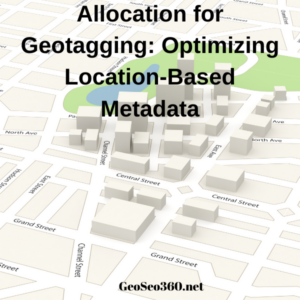What is Allocation for Geotagging?
Allocation for geotagging refers to the process of assigning and managing geographical data for images, videos, and other digital content. This involves embedding latitude, longitude, altitude, and location descriptions into the metadata of digital files, making them more relevant for search engines, mapping services, and local SEO strategies.
By properly allocating geotags, businesses, photographers, and digital marketers can optimize their content for Google Maps, Google My Business, social media, and location-based search results. This practice ensures that images and other media files accurately reflect the location they represent, leading to better visibility and engagement online.

Why is Allocation for Geotagging Important?
Geotagging is more than just adding a location to a photo—it’s about strategically allocating geotags to enhance digital content’s discoverability and effectiveness. Here’s why it matters:
1. Boosts Local SEO Rankings
Search engines prioritize content that is location-specific. Proper allocation of geotags helps Google and Bing understand where an image or video is relevant, improving rankings for local searches.
2. Enhances Google Maps Visibility
Geotagged content uploaded to Google My Business (GMB) and Google Maps improves business visibility. This means more customers can find your business when searching for products or services in a specific area.
3. Strengthens Social Media Engagement
Platforms like Instagram, Facebook, and Twitter use location-based content discovery. Proper geotagging ensures that your photos appear in relevant location-based searches on social media.
4. Increases Trust and Authenticity
Customers trust businesses that provide real, location-based images. Geotagging proves that a business or service is genuine and operational, making customers more likely to engage.
5. Optimizes Content for Geolocation Marketing
For businesses running location-based advertising, geotagging ensures that ads and promotional content reach the right geographic audience, increasing ROI.
How to Properly Allocate Geotags for Optimization
To ensure effective geotag allocation, follow these steps:
Step 1: Choose the Right Geotagging Tool
Using an online geotagging tool like GeoSeo360.net makes it easy to allocate geotags efficiently. This tool allows you to:
- Upload images
- Add precise latitude and longitude coordinates
- Embed metadata descriptions
- Download geotagged files for SEO and digital marketing
Step 2: Assign Accurate Location Data
When geotagging content, ensure that you:
- Use exact coordinates from Google Maps for accuracy.
- Avoid false or misleading locations, as search engines penalize incorrect geotagging.
- Allocate geotags to multiple images related to the same location for consistency.
Step 3: Optimize Metadata with Keywords
Along with geotags, include SEO-friendly keywords in the image metadata, such as:
- “Luxury hotel in Miami with ocean views”
- “Best coffee shop in New York City”
- “Top-rated hiking trail in Colorado”
Step 4: Upload Geotagged Images to Google My Business
For maximum impact, upload geotagged photos to GMB and Google Maps, helping improve:
- Google Search rankings
- Google Maps visibility
- Local customer engagement
Step 5: Monitor and Update Geotagged Content
Regularly check your geotagged content to ensure it aligns with:
- Changes in business locations
- Updated marketing strategies
- New SEO trends
Best Practices for Geotag Allocation
- Use High-Resolution Images – Google prefers clear, high-quality images for better indexing.
- Geotag Multiple Images – The more location-tagged photos you have, the stronger your SEO signal.
- Ensure Location Relevance – Geotags should match the actual location of the business, event, or service.
- Use Geotagging for Videos – Videos can also benefit from accurate geotag allocation for better YouTube SEO and social media reach.
- Optimize for Mobile Search – Since most users search for businesses on mobile devices, geotagged images help them find relevant locations faster.
Effective allocation for geotagging is a crucial strategy for businesses, marketers, and content creators looking to enhance their local SEO and digital presence. By properly managing geotags through tools like GeoSeo360.net, businesses can increase their Google Maps rankings, improve search visibility, and attract more location-based traffic.
Start optimizing your content with geotagging today and stay ahead of the competition!
